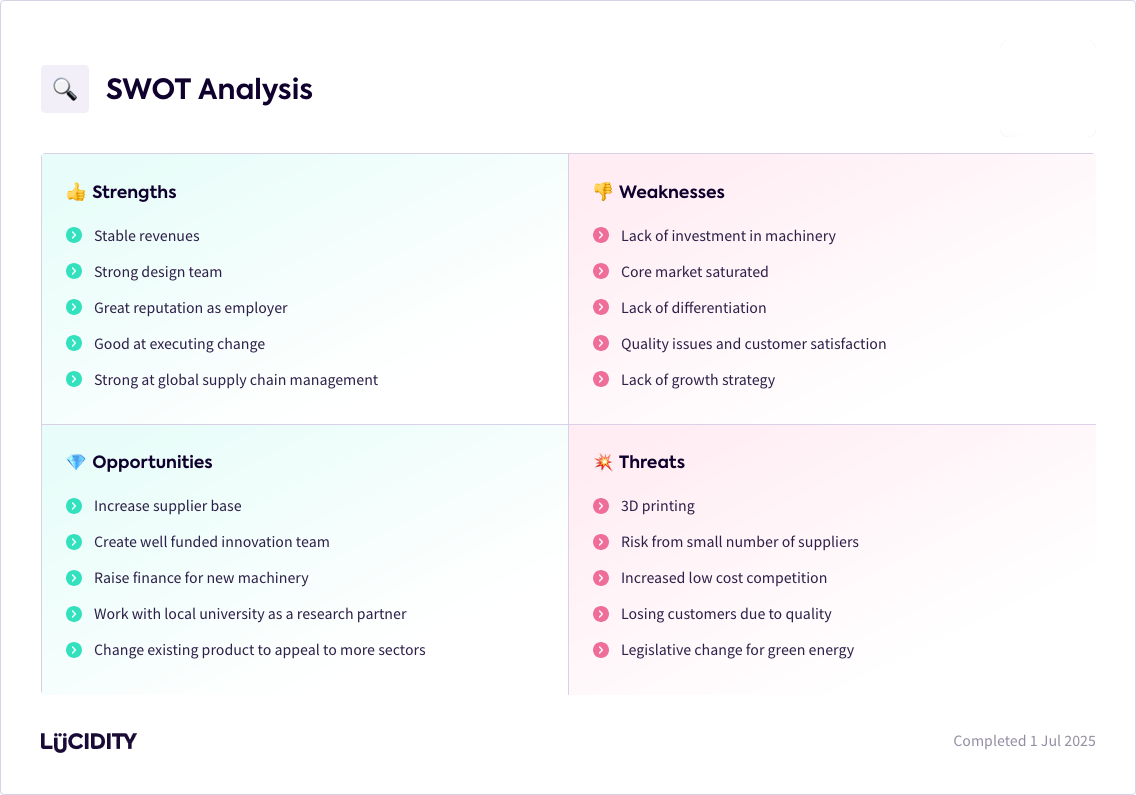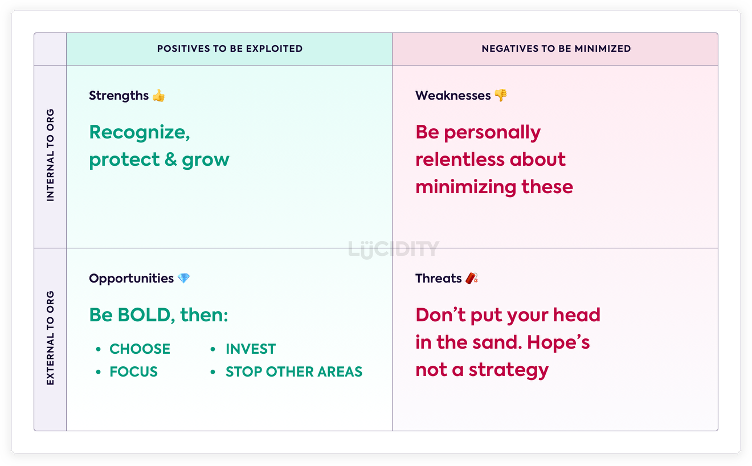As the CEO of a manufacturing company, few tools are as immediately practical and broadly impactful as a well-constructed SWOT analysis. It provides a clear, concise summary of where your company stands — what it does well, where it falls short, the opportunities it could seize, and the threats it must manage. And from this you should be able to derive exactly where you personally should be focussing to make a difference.
The SWOT you complete hopefully offers a snapshot of a capable business, but also one with critical areas that need your attention. This summary helps you unpack that SWOT in detail, reflect strategically, and walk away with actionable considerations to guide your leadership and planning decisions. Let’s use an typical or example SWOT for a Manufacturing Business.
Strengths: What You’re Doing Well
- Stable Revenues: This suggests a mature business with reliable demand. Consider whether revenues are growing or flat and whether margins are healthy.
- Strong Design Team: Product design affects quality, cost, and innovation. Ensure they collaborate with production and get direct customer feedback.
- Great Reputation as Employer: A strong employer brand helps attract and retain talent. Use this advantage to build pipelines and market credibility.
- Good at Executing Change: Change capability is rare and valuable. Use it to implement more transformative strategies, such as digitisation or product diversification.
- Strong Global Supply Chain Management: This offers resilience and efficiency, but regular supplier risk assessments and diversification remain crucial.
Weaknesses: Areas That Need Focus
- Lack of Investment in Machinery: Outdated equipment can restrict capacity, quality, and efficiency. Explore financing for modernisation.
- Core Market Saturated: Consider targeting adjacent sectors, new geographies, or premium/lower-cost product lines.
- Lack of Differentiation: In commoditised markets, service, speed, sustainability or unique customer experience can help you stand out.
- Quality Issues and Customer Satisfaction: Use quality metrics like complaint rates and returns to guide corrective action. Make quality a leadership priority.
- Lack of Growth Strategy: Without clear direction, momentum fades. Engage your leadership team in a 3-year strategic visioning process.
Opportunities: What You Could Be Capitalising On
- Increase Supplier Base: Broaden your supplier network to reduce dependency and increase negotiation power.
- Create a Well-Funded Innovation Team: Even small innovation programs can yield new ideas, services, or cost-saving processes.
- Raise Finance for New Machinery: Modern equipment improves quality, throughput, and energy efficiency. Create a capex plan tied to ROI.
- Partner with a Local University: Tap into research, innovation grants, and student talent. Partnerships can improve credibility and R&D output.
- Adjust Products for Other Sectors: Reconfiguring existing products can unlock new market segments or use-cases.
Threats: External Risks to Monitor and Prepare For
- 3D Printing: Additive manufacturing is reducing barriers to entry. Consider adopting it for prototyping or niche runs.
- Supplier Concentration Risk: A small number of suppliers increases vulnerability. Build supplier scorecards and mitigate dependency.
- Low-Cost Competition: Outsourcing and global competition continue to pressure margins. Lean into service, reliability, or ESG factors for an edge.
- Customer Loss Due to Quality: Reputation damage can be hard to recover from. Invest in quality assurance and customer listening tools.
- Green Legislation: Climate regulations and energy laws are tightening. Begin aligning with net-zero and sustainability targets now.
What should CEOs actually do about their organisation’s strengths, weaknesses, opportunities & threats?
Well….
Strengths – You need to recognise, protect and invest in these. Invest most in your biggest strengths if you want to build and maintain true competitive advantage.
Weaknesses – A CEO ought to eliminate what’s on this list. As the CEO, you have the authority to quickly cut through and deal with issues here that other managers may struggle to affect.
Opportunities – Choose which opportunities to focus on and cut the rest. Be brave. Strategy is about choice – what to focus on and what to say no to.
Threats – You can’t ignore these. Prioritise them and give them an owner. Use your strengths to eliminate threats. Simple example: Got a great CMO? (strength). Competition catching up? (threat). OK, so focus your CMO on running a campaign against that competitor.
Final Thoughts for the CEO
This SWOT highlights a business with operational strengths and leadership potential — but facing serious external threats and strategic gaps. Many of the risks and weaknesses are solvable, particularly with your existing capabilities in design, change management, and supply chain execution.
Use this as a working document: revisit your strategy, set clear objectives, and align your leadership team around 2–3 focused priorities. In today’s environment of rapid disruption and digital transformation, strategy must be both clear and flexible.
Next Steps:
- Hold a leadership strategy session to align on the biggest opportunities and threats.
- Translate each SWOT area into measurable goals or actions in your strategic plan.
- Build true competitive advantage by investing in your biggest strengths.
- Regularly update the SWOT as your market conditions, customer expectations, and internal capabilities evolve.
With clarity and discipline, this analysis can be the start of a confident and effective strategic roadmap for your manufacturing business.













